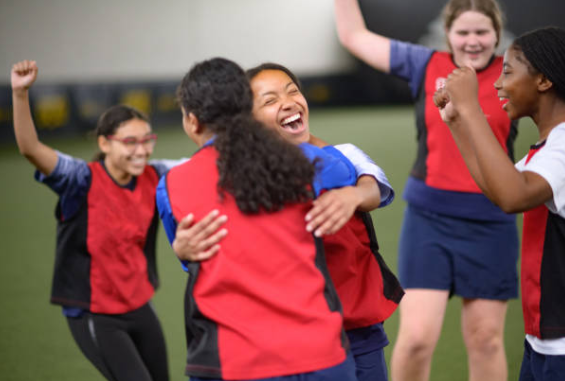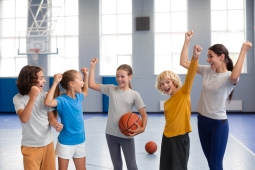Mission Possible: Improving Girls' Participation in PE Class

Previously published in Volume 83, Issue 1
It’s an unfortunate truth: boys tend to be more involved in physical education class and join co-curricular teams more frequently than girls. As a PE teacher and coach, I want to get girls more active in my class and encourage them to be part of the co-curricular teams happening here at my school.
The question is, how can I do this? In my teaching experience, I find girls will often give the ball to the boys, or back away from a group of boys who are bumping and pushing, or just stand on the perimeter of a game. How do we get the girls involved in those games and help move them into the middle of the action?
1. A “TGFU” approach in class
In my classroom, we’ve made a shift from skills-based teaching and the teaching of traditional games to a more fun-based approach. The “Teaching Games for Understanding” (TGFU) principle has encouraged the girls to be more involved in the games. Replacing a ball with a rubber chicken, for example, changes basketball from a skill-based game to a silly one, with everyone attempting to chuck the chicken at the net while they're also working on spacing and passing. Ultimately, it makes the playing field more equal for everyone.
Playing Tic-Tac-Toe with real people is another example of a game that gives everyone a chance to build on PHE skills including teamwork and spatial awareness—in a way that’s fun, playful and interactive. I found gradually shifting to this TGFU approach helped to change the mindset of a number of girls, and as a result they became more active in general, and more engaged in class.
Students (including boys) were able to realize they didn’t have to be the best athlete in class to be successful. Our goal is to ensure everyone is active and having fun, and becoming physically literate learners. By making physical activity fun, we are able to get more students interested and wanting to be part of class. Hopefully, that’s a step in the direction of life-long physically activity.
2. Girls-only practice sessions for co-curricular teams
The next challenge was to encourage more girls to be part of our co-curricular teams. Even though we focus on inclusivity in the classroom—on working together and playing together—I’ve found that many girls in Grade 5 and 6 are intimidated by the boys, who are often more aggressive, louder and don’t share well the girls.
The solution? After conducting a poll of the Grade 6 girls, we decided to try girls-only basketball practices for Grade 5 and 6 students. The results were positive and immediate: The first practice saw the attendance jump from 10 to 25. At the second practice, more than 30 girls joined in. From then on, we held girls-only practices for certain sports, including basketball and ball hockey, with an average of 30 to 50 girls attending each one.
According to the students involved, they prefer the girls-only practices because:
- They’re more comfortable playing against other girls.
- They’re getting to handle the ball more, to develop their skills, and to contribute more to the game.
- They feel more comfortable taking chances—and possibly failing—when practicing on an all-girl team.
- They feel they have a voice and can take on leadership roles within their teams.
We’ve found these steps have been helpful at our school in encouraging girls to join in and stay active. So far, what we are doing is working. Hopefully they’ll continue to keep coming out, to play hard and to have fun!








